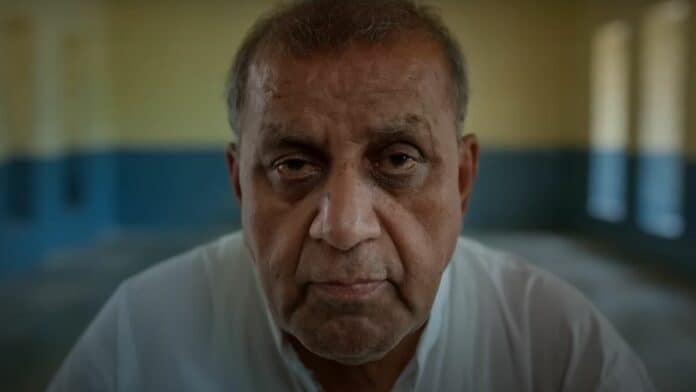Dancing on the Grave documents the murder of Shakereh Khaleeli, which took place in Bangalore in the early ’90s, and the subsequent investigation. The docuseries is now streaming on Prime Video.
Warning: This article contains heavy spoilers
Plot summary
Shakereh Namazie was the granddaughter of the Diwan of Mysore; she came from one of the most prestigious families of Bangalore. She was married to Akbar Khaleeli, who served in the Indian Foreign Service, and they had four daughters together.
When Akbar Khaleeli gets posted in Iran, Shakereh and their daughters stay back in India. This is the time when she is introduced to a gadman named Murli Manohar Mishra, also known as Swami Shraddhananda, at the house of Begum of Rampur.
In her husband’s absence, Swami Shraddhananda starts helping Shakereh with the estate and running various kinds of errands for her. Whenever he comes to Bangalore, he stays at Shakereh’s house.
On the other hand, Shakereh’s relationship with her husband gets worse with each passing day, as they do not agree on a lot of things, and in 1985, they get divorced. Their daughters move to Italy, where Akbar Khaleeli is posted.
Just six months after the divorce, Shakereh marries Swami Shraddhananda; the marriage is spurned by Shakereh’s family and community, and Shakereh is as good as ostracized. It is only Sabah, one of Shakereh’s daughters, who keeps in touch with her.
In 1990, Shakereh’s daughters return to India, and Shakereh tells Sabah that she is planning to move to London. Soon after, Shakereh disappears.
Sabah does not hear from her mother at all, and when she tries to contact her, it is Swami Shraddhananda who receives the phone and makes up an excuse every time.
Sabah even comes to Bangalore from Mumbai to meet her mother, but Shraddhananda continues making up excuses to justify her absence; he even tells her that her mother is pregnant and in a hospital in the US.
Finally, she decides to go to the police and file a missing persons report in 1991. The police fail to figure anything out for three years, and then the case is handed over to the crime branch. The officers find out that Shakereh never went to London, as Shraddhananda had claimed.
Shraddhananda is brought in for questioning, but he does not tell the police anything. Since the authorities have no evidence, they keep an eye on Shraddhananda in the hope of finding some clues that would help them solve the case.
The caretaker of the property tells the constable, who has been watching Shraddhananda, about a wooden box that Shraddhananda got made. Additionally, the house help tells them that he has been performing a ritual that is performed at a site where a person is cremated.
On top of that, Shraddhananda starts selling Shakereh’s property but refuses to sell the place where his living premises are located. Due to all these factors, the authorities interrogate him.
Dancing on the Grave ending explained in detail:
What happened to Shakereh?
He then reveals that Shakereh was going to take the property that she had given to Shraddhananda from him, as he had failed to keep his promise of giving her a male child. He feared that she might ask him to leave altogether, so he sedated her by drugging her tea.
He then put her in the wooden box and buried her. He shows the authorities that he had buried her in the courtyard of their house, the very place where he frequently hosted parties, danced, and enjoyed with other people even after her death.
The authorities recover Shakereh’s remains. Judging by the scratches made by her on the inside of the box, it is believed that Shakereh was buried alive.
When Shakereh’s remains were found, her parents wanted to bury her in a Muslim graveyard, but they were not allowed to do so, as the people of her community did not approve of her marrying Shraddhananda. Shakereh never received a proper burial.
What is Swami Shraddhananda’s claim?
Shraddhananda insists that he is innocent. Shakereh had left her property to Shraddhananda in her will and had given him the power of attorney. Additionally, he divided the property into small plots and started selling it.
Shakereh’s mother then filed several cases to take back the property she had given Shakereh, as she wanted Shakereh’s daughters to inherit it.
According to Shraddhananda, Shakereh was very stressed because of this. He came home one day and found her dead. He thought he might be blamed for her death by her family, so he decided to bury her body.
He claims that they did not have any marital problems and were happy with each other, as they even had a son, but the son did not survive. He now says that the police tortured him and forced him to sign a confession.
Is Shraddhananda found guilty?
It is hard to prove in court that Shraddhananda had murdered his wife, as there are no witnesses and the evidence is circumstantial. However, Shraddhananda is found guilty in the High Court and sentenced to death.
The case is also heard in the Supreme Court in 2007, and Shraddhananda is found guilty again, but this time, he receives a life sentence. He is found guilty by a total of eight judges in various courts.
He has spent nearly 30 years in prison. He still claims innocence and has even filed a mercy petition. The outcome of the petition is still pending.

